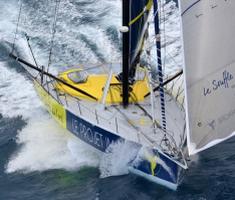 The seas are growing increasingly cluttered. In addition to all the other hazards of the sea, floating objects are a serious threat to sailors. So far, of the original 29 competitors in the Vendee Globe singlehanded around the world race, 5 have been forced to retire after being damaged by collisions with UFOs, unidentified floating objects. Another boat, Hugo Boss, sailed by Alex Thomson, lost a foil daggerboard to a UFO, but has managed to keep sailing, and is now still in second place. Three other Vendee Globe racers have retired for reasons not related to collisions — two due to dis-masting and the other from damage to a foil in heavy weather.
The seas are growing increasingly cluttered. In addition to all the other hazards of the sea, floating objects are a serious threat to sailors. So far, of the original 29 competitors in the Vendee Globe singlehanded around the world race, 5 have been forced to retire after being damaged by collisions with UFOs, unidentified floating objects. Another boat, Hugo Boss, sailed by Alex Thomson, lost a foil daggerboard to a UFO, but has managed to keep sailing, and is now still in second place. Three other Vendee Globe racers have retired for reasons not related to collisions — two due to dis-masting and the other from damage to a foil in heavy weather.
A rundown of the collisions with UFOs:
- The worst collision with a floating object was the most recent when Thomas Ruyant struck what is believed to have been a floating container in his boat Le Souffle du Nord pour Le Projet Imagine, at a speed of 17-18 knots. The collision, which took place south of New Zealand, crushed the bow of the boat. Ruyant is now motoring toward new Zealand.
- Early in the race, Bertrand de Broc, sailing MACSF, collided with an object off Portugal and was forced retire from the race.
- Vincent Riou on PRB hit a UFO on the West coast of Africa and had to retire after suffering keel damage. Riou was the winner of the 2004 Vendée Globe.
- In early December, French skipper Kito de Pavant, aboard his boat Bastide Otio, struck an object in the Southern Ocean which destroyed his keel housing, ripped off his aft keel mountings and left the appendage supported only by the hydraulic keel ram. Pavant was subsequently rescued by a French research and supply vessel.
- Morgan Lagravière on Safran retired from the race after rudder damage believed to have been caused by a collision with a UFO.
Despite losing his starboard foil daggerboard in a collision at an estimated 22-24 knots, Alex Thomson sailing Hugo Boss is till holding on to second place overall.

One or two (Alex Thomson, for instance) may have hit whales. Vincent Riou pointed out that sonar equipment powerful enough to detect them (or the containers and other inert rubbish) early enough to have a chance of avoiding them is currently far too big and heavy, at around 100Kg (220lbs). Let’s hope someone is working on it…
More than powerful– highly directional and high resolution. So a chirper?
Looking at the way these boats behave in the water suggests that a useful sonar would be difficult to implement; little of the nominally wetted surface of the hull is predictably and consistently in contact with water. Possibly transducers could be located on the bulb of the keel?
In Ruyant’s case all 1 (one) of the crew seems seems to have been its bunk when the strike happened. Leaving aside that in that case nobody was awake to be practicing “see and avoid,” sonar also needs a watchkeeper to be fully useful.